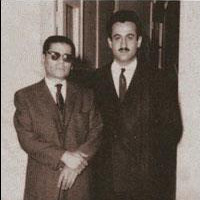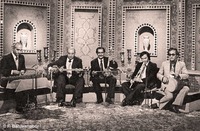Muhammad Ismaili
Muhammad Isma‘ili (1934-)
Tumbak instrumentalist and instructor. He was one of the first young tumbak instrumentalists performing in the earlier Golha programmes accompanying Amir Nasir Iftitah and Jahangir Malik (1945). At the National Conservatory of Music in Tehran he was generally recognized as the worthiest successor to the great tumbak maestro Husayn Tehrani,. After the demise of his master, he developed his own classical teaching programme and invented advanced techniques of playing the tumbak, while also authoring a number of books with his most talented and prominent student, Siyamak Bana’i (b. 1957), which have been released with CD and DVD albums (Tehran: Mahur 1995-2005).
Following years of performance at different orchestras of the Ministry of Culture and Art, and at the orchestra of Tehran Radio and Television, Muhammad Isma‘ili rejoined the Golha programmes in 1968 and made numerous performances there both as a soloist and accompanist to the orchestra conducted by Faramarz Payvar right down until 1979. His extraordinary ability in performing complicated pieces with sophisticated techniques have been appreciated by classical tumbak instrumentalists and his contributions to performance on this instrument have been compared to the educational and cultural contributions made by the most prominent contemporaneous instrumentalists like Faramarz Payvar and Hushang Zarif in their own respective fields. The zenith of his musical abilities can be seen in his accompaniment of the santur of Faramarz Payvar and the tar of Jalil Shahnaz of which numerous recordings were made. Following the 1979 revolution, he was obliged to confine and seclude himself within his home, which led to him developing a mystical bent and choosing Sufism as his path of life. Sufi mysticism bestowed a new perspective on his art and graced it with fresh lustre, vouchsafing his cultural, artistic and social activities with a profound spiritual dimension. He is still active and has released numerous works.


 In association with The Iran Heritage Foundation © All rights reserved 2025. Jane Lewisohn | Website by
In association with The Iran Heritage Foundation © All rights reserved 2025. Jane Lewisohn | Website by